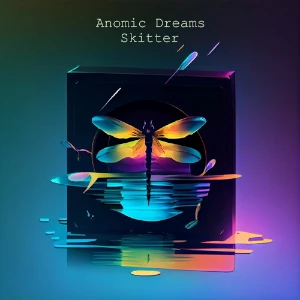The Writing of Anomic Dreams
Published on March 25, 2025
Anomic Dreams is the first single I released.
It began with a vision of making one of those beautiful, flowing, melodic tracks and I decided to try going down the road of color bass. The introduction and "verse" sections of the song try to capture the feeling of lazy water drops and it builds an atmosphere for the listener to step inside. It uses a laid-back snare, which I try to do if I have the chance. Unusual snares are a fun rabbit hole.
The chorus draws from color bass influences and cascading arps in the background continue with the water theme. Basses in this section use a combination of comb filters, resonators, and convolution reverbs to achieve their harmonic texture. The next verse brings with it a distorted, brass sound filling out the low end and adding tension. At the same time, a slow, bendy guitar adds melody to the atmosphere and a synth meanders through a few different modes. The melodies bring something new to the piece without drawing too much attention from the atmosphere, which was the goal.
Then the song comes to an energetic climax with strong hits and lots of space. It’s an opportunity to reframe the melodies and rhythms you heard throughout that first chorus. And finally, the outro. It’s honestly my favorite part of the song! I love the reversed aesthetic, stuttering glitches, and how it is a new variation on one of the chorus harmonies that stands alone without sounding foreign.
That guitar solo in the second verse was a total afterthought. During the writing process I felt like that section needed something else added, sat down with a guitar to get an idea of what might fit, improvised that little bit, and immediately dialed in the tone and tracked it not a minute later. I fell in love with it right away. It wasn’t “supposed” to be guitar on that melody, but after I heard that improvised on the guitar, I knew nothing else would approximate that playful feel it has.
The writing of Anomic Dreams was a three month-long process, and after that I knew I never wanted to go through that again! Three months was way too much time to put into a single song, and a large part of that was the inexperience of not knowing what I wanted. So rather than continuing to produce the way I was, I spent a year and a half finding a process and workflow that I love. Which leads us onwards and upwards to the release of Sunken Churches!
Random Technical Details
All the synths and plucks you hear are Serum presets I’ve made! I’ve grown a lot since this song was written, but they’re still not too shabby. I try to make all the sounds used in my songs by hand (or use presets I’ve already made). That way my sonic fingerprint is guaranteed to be in every song and my sound design skills grow with every song. I’m currently working on my own preset pack for Serum 2, tentatively named Fuzzy Keys.
There are a few sounds that I can’t get enough of that I use standalone synths for. Stage-73 V2 by Arturia is great for Rhodes and Wurlitzer style vintage key sounds, and Le Gibet by Teletone Audio encapsulates a specific aesthetic in music that I love. When I’m not sure what I want to start writing with, if I don’t have some experimentation in mind, I like to grab one of those to start! If you know what sounds instantly inspire you, never put them out of reach.
All my processing chains are done manually for each track in each song. I don’t take a one-size-fits-all approach or have any standard racks with knobs to dial things in. Each sound gets the effects and processing it deserves as I’m writing the track. I’ve always used Reaper as my main DAW. I’ve tested a handful of others, but they all have their own quirks that slow down or limit your workflow in specific ways. Reaper has always been fully featured and what treats my workflow best.
If you have any questions about the song, anything in my workflow, what goes into processing certain sounds, or the specifics of any presets, don’t be a stranger! Send me a message: [email protected]
ttyl
— Skitter
